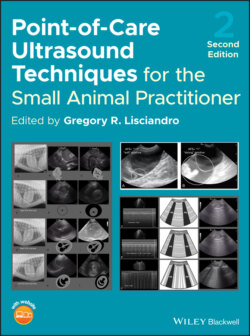Читать книгу Point-of-Care Ultrasound Techniques for the Small Animal Practitioner - Группа авторов - Страница 146
Naming and Order of the AFAST Views
ОглавлениеThe AFAST sites in the preferred positioning of right lateral recumbency (over left) are named according to target organs at each acoustic window and performed in clockwise order as follows: (1) DH view, (2) SR view, (3) CC view, and (4) HR umbilical (HRU) view that completes the AFAST examination and is a favorable site for abdominocentesis, being most gravity dependent (Lisciandro et al. 2009; Lisciandro 2011; Boysen and Lisciandro 2013; McMurray et al. 2016). AFAST views are shown translated onto an abdominal radiograph and CT study in Figure 6.6. The final view is the HR5th bonus view to image the right kidney and nearby liver that is not part of the AFS; the HR5th bonus view is generally performed as the final view after AFAST, TFAST, and Vet BLUE have been completed.
In LL recumbency the order is as follows: (1) DH view, (2) HR view, (3) CC view, and (4) the SR umbilical (SRU) view that completes the AFAST examination and is a favorable site for abdominocentesis, being most gravity dependent (see Figure 6.3). Positioning of the cat is shown in Chapter 39. The final view is the SR5th bonus view to image the left kidney and spleen and is not part of the AFS; the SR5th bonus view is generally performed as the final view after AFAST, TFAST, and Vet BLUE have been completed (Lisciandro et al. 2009; Lisciandro 2011; Boysen and Lisciandro 2013; McMurray et al. 2016).
In summary, the four primary AFAST views are part of the AFS system. The AFAST 5th bonus view (HR5th and SR5th views depending on which lateral recumbency is being used) is not part of the AFAST AFS system, but important for acquiring information for that respective retroperitoneal space and any obvious soft tissue or parenchymal abnormalities of the kidney and its adjacent liver and spleen dependent on positioning. In cats and smaller dogs when using enough depth, both kidneys are often seen through the SR (or HR) view (Lisciandro et al. 2009; Lisciandro 2011, 2012, 2014a; McMurray et al. 2016) (see Figure 6.21).
Pearl: By imaging using the AFAST target organ approach, sonographic anatomy is better recognized, and the sonographer is building POCUS skills on every AFAST exam, with the only pressure being the recognition of free fluid.
